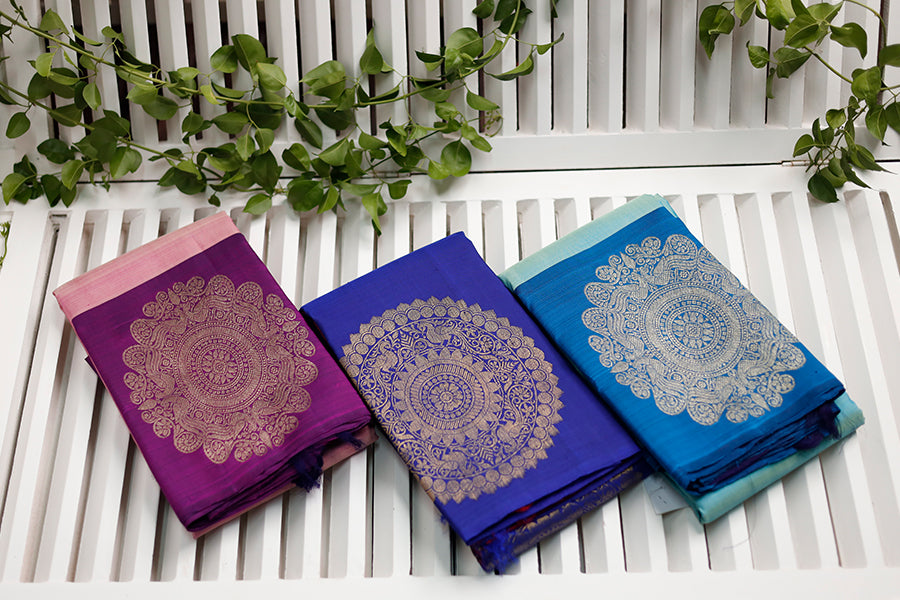I hear the faint sound of the loom going ‘rap trap rap’ and the special scent of the agarbatti emitting out of a doorway from the streets of Kanjeevaram, an ancient temple town close to the city of Chennai. As I follow the scent I enter a small room where I see the art of Indian handloom weaving unfold before me. The sound and the smell has made me get into a trance of sorts and is quite meditative in nature.
You might be surprised to note that these sights and sounds are same across any weaving community across India. Can you imagine that each of these communities in different geographical location across India produces a unique weave! Be it the famous Kanchipuram silk, Sungadi, Rasipuram, Thribhuvanam from Tamil Nadu, Mangalgiri, Ikat from Andhra Pradesh, sambalpuri from Odissa, Chanderi from Madhya Pradesh, Banares weaves of Varanasi, Paithanis of Maharashtra to the precious Patan Patola (the double Ikkat) from Gujarat. Not to mention the unique nature of tribal weaves and silks from the North Eastern States such as Assam, Manipur and Meghalaya. The collection that India offers is simply astounding!

So what is the handloom weave?
A handloom is a simple machine used for weaving. In a wooden vertical-shaft loom, the heddles are fixed in place in the shaft. The warp threads pass alternately through a heddle, and through a space between the heddles (the shed), so that raising the shaft raises half the threads (those passing through the heddles), and lowering the shaft lowers the same threads — the threads passing through the spaces between the heddles remain in place. This when used alternatively creates the ‘rap’ sound that I mentioned earlier.
The art of handloom weaving essentially involves three stages:
- The manufacturing process of the yarn
- The dyeing process
- The weaving process

The manufacturing and making of the cotton or silk yarn is an intricate process involving craftsmen who have been practicing and perfecting the art over many centuries and India is considered to be the world’s best handloom hub. Handloom weaving is a community activity located in specific groups across India. Sometimes an entire village’s livelihood centres on handloom weaving and activity has involved families across generations.
Journey of Handloom
Handlooms are labour intensive, time consuming, yet worth all the effort and time for the wonderful product that emerges out of it. The art was on the decline a few years back has seen a revival the last two decades. It has taken over a new avatar with SHGs (Self Help Groups), NGOs and Government taking an active part in its revival and restoration. With NIFT and other fashion institutes, Craft Council of India and designers giving it the much required leg-up, Indian handloom is now internationally known and well appreciated worldwide. There are takers who appreciate the craftsmanship both within India and in the West. Celebrity endorsement is of course another added crown.
So why Handloom?
Due to the fact that it is made of natural fiber such as cotton, jute, linen or silk, handloom fabric is suitable for all weather conditions – be it the cold of the winter or to remain cool and comfortable during summer. The breathability of the fabric is the reason for it.

The sheer creativity of the craftsman comes into play in a handloom fabric- the range of colours and the intricate and varied designs are much to marvel about in this craftsmanship. Weavers incorporate their creativity with their skilful blending of shapes, symbols, myths, faiths, and imagery, giving the fabric its uniqueness and appeal. It is available in a range of fibers like cotton, silk, jute, linen and wool and sometimes as blend of two varieties.
A unique character of a handloom fabric is the irregularities or variations present in the weaving which are inherent to the product and which adds to its uniqueness and value and should not be considered as a flaw. Handlooms can provide a modern or traditional product for every strata of society. It projects a unique image of sustainability as it is biodegradable and the production process is environment friendly. The sector provides employment opportunities to lakhs of workers and their families accounting for 12% of the total cloth produced in the country.
Celebrities and handloom
Handloom has become a statement piece be it among the fashion circles or in a boardroom. Every fashion collection across the globe celebrates the handloom fabric. It is now considered a ‘renaissance’ moment among the Indian fashion circles. With the active endorsement of the Prime Minister and sincere efforts of ministers like Vasundhara Raje and Smriti Irani and prominent designers we can expect to see bright days ahead for the handloom.
Celebrities of course create their own unique appeal be it Nandita Das making a bold fashion statement at Cannes or effortlessly and beautifully donning a Kanchipuram by the likes of a Rekha and Vidya Balan- the Indian handloom will always remain an ethereal beauty.

Endorsement from leading actresses of the current generation like Sonam Kapoor, Kangana Ranaut, Huma Qureshi increases the appeal of this desi attire to the impressionable youth who are the largest customer base that it should appeal to.
What can we do to support the cause?
As the ‘Made in India make in India’ slogan goes, our small way to make a contribution in sustaining this art and craft form is to get to know more about it. Believe me, the details and difference about each weave will astound you! Did you know that the loom uses its own code form, talk about the ancients using bits and bytes!

Secondly, try and include a handloom fabric as part of your wardrobe staple. It need not be a saree as handloom fabrics are now widely used to make modern outfits such as dresses, shirts, kurtas, kurtis etc., Handlooms are also used to make even bedsheets and towels.
Thirdly, if possible try and use your travel in each part of the India to visit the nearest handloom village. You get to see first-hand the time and effort and the artistry that it involves and the sheer genius of the workmanship. It will surely put a smile on their face and make you feel that you have done a good deed for the day. Trust me, you won’t regret it. Thank me later.
The S Studio’s connect with Handlooms
There are indeed wonderful initiatives taken by enterprising entrepreneurs like Subha Srinivasan of The S Studio who are going all out to encourage the art of handloom weaving by working with and promoting artisans across India. The S Studio, an online saree boutique specialising in hand-crafted sarees in Chennai is known for their collection of Kanchipuram silks, Tussars, Kalamkari sarees etc., Do check their collection at www.thesstudioonline.com



